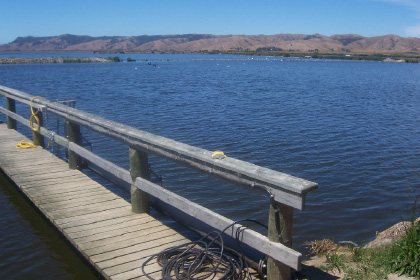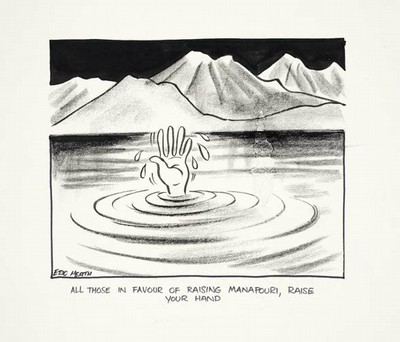Draft master plan and the mother of master plans

Algae-Fueled Aviation: The Marlborough oxidisation lagoons where Aquaflow Bionomic Corporation harvests algae—from which it succeeded in producing a synthetic fuel that, when blended with kerosene, can power commercial aircraft. photograph Kirsten Rodsgaard-Mathiesen©
New regional governance arrangements will likely see Watercare Services responsible for Mahurangi sewerage. Understandably, Rodney District Council’s infrastructure planners are keen to consolidate their work prior to when, in all probability, they will report to new masters.
Or not. Outsiders can only speculate as to how disconcerting it must be for the staff of a council in the throes of its latest effort to secede from the region, as a unitary authority. Certainly the Royal Commission on Auckland Governance was scathing:
The Commission observes that the submissions of the Rodney and Franklin District Councils were directed principally at protecting the existence of those two councils, with limited regard to regional issues.
To further test the mettle of its engineers, the entire body of work on the northeastern Rodney sewerage strategy that has been with Harrison Grierson Consultants for four years has now to be transferred the new supplier of professional services to the district council, GHDformerly known as Gutteridge Haskins & Davey.
Harrison Grierson, in time to handover to GHD, has produced a draft Mahurangi Wastewater Master Plan, which reflects Rodney District Council’s shortlist of two options for the Mahurangi component of its northeastern Rodney sewerage strategy:
- Maintain and progressively upgrade existing treatment plants at Snells Beach and Warkworth
- Combine Warkworth with an upgraded Snells Beach treatment plant.
The first, status quo option would see a continuation of the discharge of treated effluent into the Mahurangi River. The second option would see a cessation of the river discharge, in favour of the existing ocean outfall at Back Beach, south of Martins Bay. A third option is short-listed but it only directly effects the areas of northeastern Rodney north of the Mahurangi. It provides for a new plant for Leigh–Matheson Bay, as opposed to piping untreated sewage to an upgraded Ōmaha facility. In either option, the effluent is to be re-used as irrigation in the free-draining soils of that area—the Ōmaha Golf Course currently absorbs the lion’s share of the well-treated wastewater.
Land disposal was considered for Warkworth, but that option was eliminated. Apart from being prohibitively expensive—an estimated whopping 120% more—the chances are low of finding a willing vendor with the odd 500 hectares considered necessary to cope with wet winter volumes.
In its current draft, the master plan option to end the widely resented river discharge would probably be scuttled by inevitable not-in-my-backyard sentiments in Snells Beach. In comparison, its higher cost—an estimated 13.5%—is a low hurdle. Aside from those considerations, community reaction to the options currently short-listed would come from two camps:
- Think small and force every property to treat wastes onsite.
- Think smart–green and re-use 100%, or produce biofuel, or both.
The immediate driver for forming Mahurangi Actioninitially known as Friends of the Mahurangi in 1974 and opposing the Warkworth’s sewerage plans, was to ‘protect the environment’ of the river and harbour. While it was appreciated that the proposed scheme would be a vast improvement to the town’s overloaded septic tank, the community was strongly averse to the river being used for the ongoing discharge of sewage effluent.

All those in favour of raising the sea level: In the 1970s, the prospect of the level of just one lake being raised galvanised the nation. Today, the planet’s rising oceans appear to boggle political and public comprehension. cartoonist Eric Heath
An added insult was that the engineers were relegating the river to the role of a ‘buffer zone’ between the outfall and the harbour’s oyster farms. (Unsurprisingly, the plant has had be considerably upgraded during its three decades of operation.) But even in 1974 a significant objection to the proposal was that it involved a high-energy, mechanical plant. While most were simply concerned about the cost electric power the plant would consume, others were seeing the writing on the wall writ large by Manapouri and the First Oil Shock. In 2006, Sir Nicholas Stern warned the ‘business-as-usual’ road would inevitably be bad for business, never mind the planet’s, particularly the Pacific’s, poor—many islands are set to become uninhabitable.
A bulk of contemporary sewerage operating costs is electricity. One low-energy alternative is solar-powered sewage treatment. It is a mature technology involving anaerobic, facultative and maturation waste stabilisation lagoons. The Hague-based IRC International Water and Sanitation Centre declares that it is the most cost-effective wastewater treatment technology for the removal of pathogenic micro-organisms. In Aotearoa, the technology is better known as oxidation ponds.
The deal-breaker for stabilisation lagoons is the large area that they require. In a perfect world, that large area would be at a lower elevation to the community it served, exposed to prevailing winds, and be a area that was relatively unproductive.
Since deforestation, a large shoal area has developed in the upper Mahurangi Harbour. In the fullness of geological time, this would have occurred naturally. The problem with such accelerated processes is that, as well as being quick, they are dirty. And being dirty, life in the harbour suffers, particularly the benthic communities—this is why the elevated sediment accumulation rate matters. The other life form that suffers is farmed oysters. Every time the wind blows, sediment is resuspended—the harbour can be muddied in the absence of rain washing fresh sediment from the hills. Again, in the fullness of geological time, the upper Mahurangi Harbour would have formed a long low-lying island. Ōrewa Estuary has one. Eventually the island would attach itself to the shoreline as a tongue. Matakana River has one. If the Mahurangi had had such an island or tongue, and supposing the settlers had failed to convert it to pasture, today, and even in 1974, it would be highly valued as a wildlife sanctuary, and would be totally out of bounds to the wastewater engineers.
In the event, in the Mahurangi, the natural formation of such an island will be seen off by anthropogenic sea level rise. However, if a long low natural-looking island was artificially created, as well as providing said solar-powered stabilisation lagoons, its construction would make magnificent use of the river dredgings—dredging being necessary if vessels the magnitude of the Jane Gifford are to routinely navigate the Mahurangi River.
The island’s neighbours would need to want it. And adjoining landholders might, if it meant they gained all-tide access—courtesy of a dredged inshore channel—and were allowed to keep a boat at the end of a jetty. Circumnavigation of the island would be irresistible to kayakers. In conjunction with a specialised training school, it could result in Snells Beach raising generations of world-beating paddlers, rowers and sailors. The birds, and the island’s obligatory biofuel component, would form an ecotourist attraction—arriving by kayak or electric launch.
Geotechnical considerations aside, the principal problem with constructing an island of lagoons is the rising sea level, which will continue to rise regardless of whether Aotearoa and the rest of the world embraces the 40% reduction in carbon dioxide being called for ahead of Copenhagen. Not because anthropogenic water vapour, carbon dioxide, methane et al are not the culprits—the science is unequivocal, regardless of what is purported by the odd farming publication—but because of the equilibrium response. Even the concept of equilibrium is optimistic—it assumes that positive feedback will fail to fuel runaway global warming, which would see the sea level rise catastrophically by metres this century.
An island of lagoons is possibly not the answer, but it cannot be beyond the wit of the Mahurangi community and its agencies to develop a master plan that marries low-energy wastewater treatment with river dredging and the Mahurangi River Trail, thereby chalking up no end of win-wins.
Just the job for the workshops on the Mahurangi Action Plan—the mother of all master plans.
